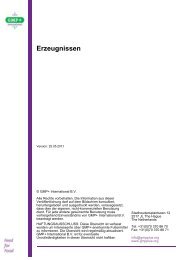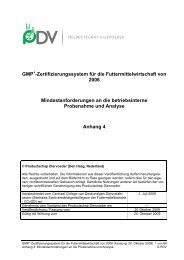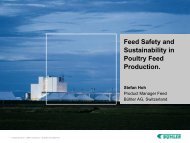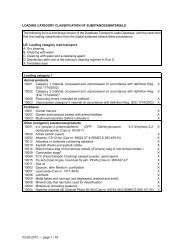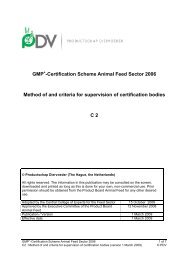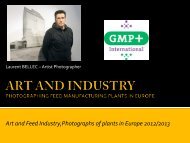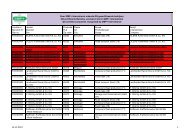Certification Scheme Animal Feed Sector 2006 ... - Gmpplus.org
Certification Scheme Animal Feed Sector 2006 ... - Gmpplus.org
Certification Scheme Animal Feed Sector 2006 ... - Gmpplus.org
You also want an ePaper? Increase the reach of your titles
YUMPU automatically turns print PDFs into web optimized ePapers that Google loves.
Re. B) Cleaning regime B (cleaning with water)<br />
Application:<br />
Cleaning with water is necessary after transport of, for instance, damp or sticky substances or<br />
possibly harmful chemicals.<br />
The general cleaning regime is as follows:<br />
remove residue from the previous load as much and as dry as possible<br />
a. pre-rinse with cold water, or warm if necessary, and difficult places.<br />
b. manual cleaning<br />
c. high-pressure cleaning with water<br />
d. dry through ventilation or hot air dryer.<br />
EXPLANATION:<br />
With open vehicles it is best to use a high-pressure cleaner with a flat nozzle with at least<br />
25 bar pressure or higher. If chemicals need to be removed, (e.g. chemical fertilisers)<br />
warm water should be used at a temperature of at least 60°C, to dissolve the chemicals<br />
more easily. Places that are difficult to reach should if necessary be cleaned separately<br />
with additional means such as brushes. It is important that the water can be drained<br />
Re. C) Cleaning regime C (Cleaning with water and cleansing agent)<br />
Application:<br />
In case of load containing protein or grease, it is necessary to use a cleansing agent.<br />
The general cleaning regime is as follows:<br />
a. remove residue from the previous load as much and as dry as possible<br />
b. pre-rinse with hot water (max. 60 °C) and clean difficult places by hand.<br />
c. foam or gel with a cleaning agent for tippers open wagons or flush<br />
with CIP cleaning agent at 80 °C in the event of tank cleaning<br />
d. rinse with water at approx. 60°C<br />
e. if necessary dry through ventilation or hot air dryer.<br />
EXPLANATION:<br />
A raised water temperature is required to remove fats more easily. This may however not be higher<br />
than 60 degrees Celsius to prevent the protein from coagulating and thereby sticking to surfaces. To<br />
facilitate the removal of protein and greases it is advisable to use a medium to strong alkaline<br />
cleansing agent, using the dosage prescribed by the manufacturer.<br />
In open systems it is best to use a foaming degreasing agent. In the case of tank cleaning with<br />
spray balls, no foaming agents may be used. It is then better to use a so-called Cleaning in Place<br />
(CIP) agent at a high temperature. In specific cases, such as the removal of calcareous substances,<br />
an acid cleansing agent is preferable.<br />
GMP+ <strong>Certification</strong> <strong>Scheme</strong> <strong>Animal</strong> <strong>Feed</strong> <strong>Sector</strong> <strong>2006</strong> 5 of 26<br />
Appendix 14 : Minimum requirements for Road Transport (version 16 November 2007) © PDV



